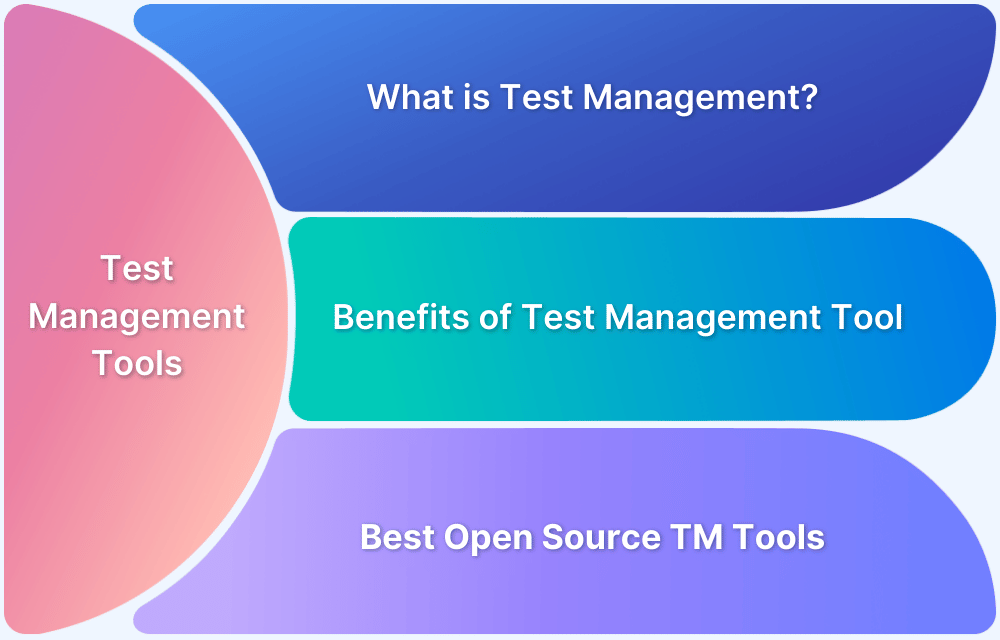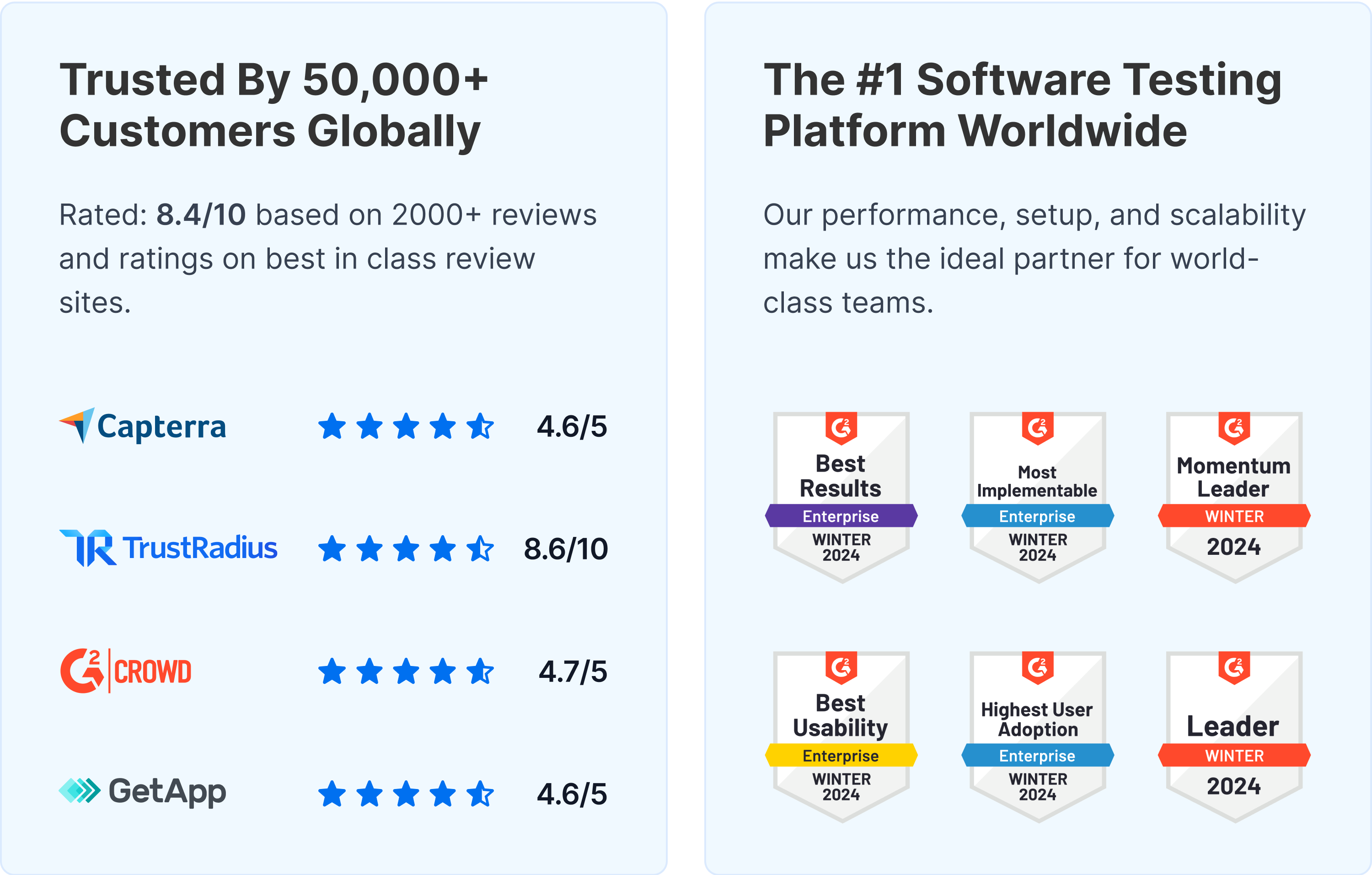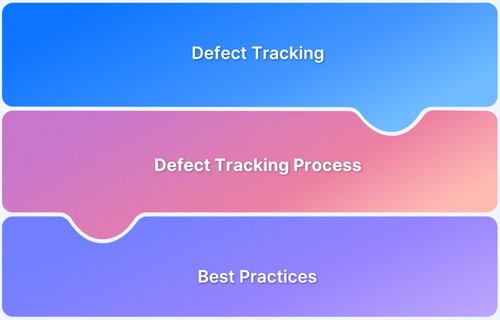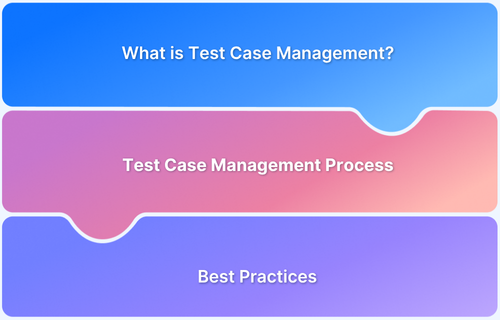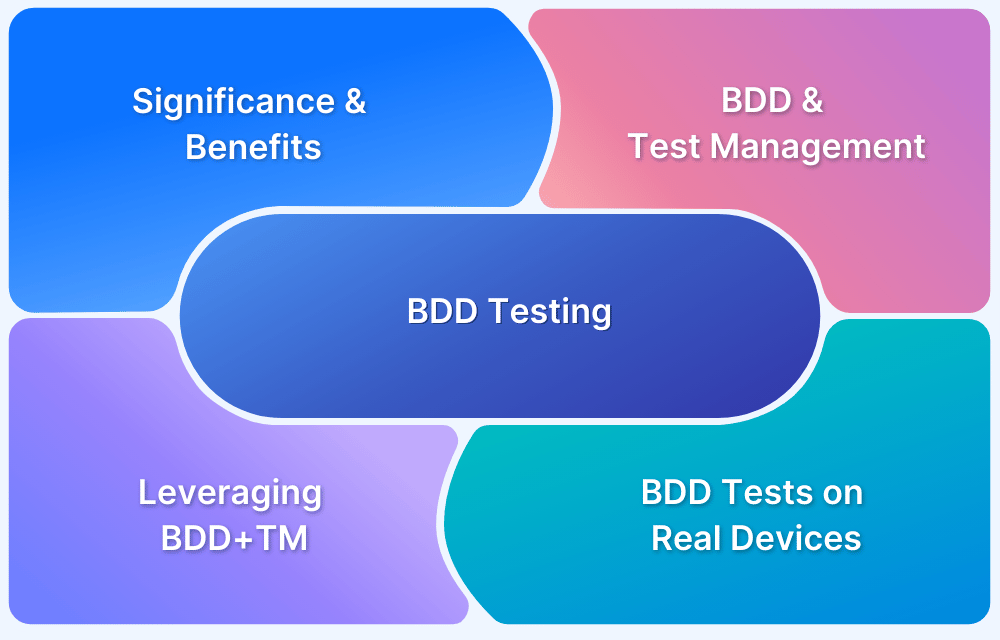Test management is a complex process that is essential for ensuring software quality. A well-managed test process can help identify and fix defects early in the software development, saving time and money. This can help to reduce the cost of software development and improve the quality of the final product. Test management ensures that software meets its requirements and is fit for its intended purpose.
Overview
Top Open Source Test Management Tools
- BrowserStack Test Management Free Tool
- TestLink
- TestComplete
- Selenium
- Specflow
- Robot Framework
- TestArchitect
- HP Quality Center (HP QC)
- Apache JMeter
- Ginkgo
This guide lists the top 11 free and open-source TCM tools, their key features, pros and cons in detail.
What is Test Management?
Test management is an essential part of the software development process. It helps ensure that software is high quality and meets users’ needs. It involves several activities, including:
- Planning: Defining the scope of testing, identifying test cases, and creating a test plan.
- Organizing: Assigning tests to testers, setting up test environments, and scheduling tests.
- Executing: Running tests and recording results.
- Reporting: Communicating test results to stakeholders.
- Managing defects: Tracking and resolving defects.
Benefits of Using a Test Management Tool
A Test Management Tool offers several key benefits:
- Enhanced Quality: Ensures thorough testing and consistent results.
- Reduced Risk: Identifies potential issues early, minimizing defects in production.
- Increased Confidence: Provides clear test coverage and results, boosting confidence in the software.
- Improved Efficiency: Streamlines test planning, execution, and reporting, saving time and effort.
- Higher Customer Satisfaction: Delivers a more reliable product, leading to better user experiences.
Also Read: 13 Best Test Management Reporting Tools
What are Open Source Test Management Tools?
Many different test management tools are available, both commercial and open source. Open source test management tools are software applications available for free and can be used to manage the testing process. These tools offer a variety of features, such as test case management, defect tracking, and reporting.
Open source or free test management tools are a great option for organizations on a budget or wanting more flexibility and control over their test management process. Many open source software test management tools are available, and the best one for you will depend on your specific needs.
Top Open Source Test Management Tools
Here are the Top 11 Open Source Test Management Tools:
1. BrowserStack Test Management Free Tool
BrowserStack’s Test Management tool is a free, unified platform that helps QA teams, developers, and project managers efficiently manage manual and automated tests. It simplifies the process of creating, organizing, tracking, and analyzing test cases across different testing stages. The tool integrates with popular project management and CI/CD systems, making it suitable for teams aiming to improve release quality and velocity.
Key Features:
- Unlimited Test Case Management: Create and manage as many test cases and test runs as your team requires, there are no usage limits.
- AI-Powered Test Case Generation: Automatically suggest and create test cases based on Jira stories and historical test data using built-in AI capabilities.
- Seamless Tool Integrations: Easily integrate with Jira, Azure DevOps, and major CI/CD tools to sync test workflows across your development lifecycle.
- Real-Time Dashboards: Track test coverage, execution trends, and failure analysis with customizable, real-time dashboards.
- Easy Import and Migration: Quickly import test cases from CSV files or migrate from other test management tools using available APIs.
- Long-Term Storage: Store test cases indefinitely, maintain a 30-day test run history, and utilize up to 10GB of file storage.
- Role-Based Access Control: Assign roles and permissions to manage access and collaboration securely across teams.
Pros
- Completely free with no limit on the number of test cases
- Simple and intuitive user interface
- Scales effectively with growing teams and projects
- Facilitates collaboration through shared dashboards and role controls
- Offers detailed reporting and analytics for better QA decisions
- Integrates smoothly with existing tools in your tech stack
2. TestLink
TestLink is a free and open-source test management tool that is used by teams of all sizes to manage their testing activities.
Features
- Test case management: TestLink allows teams to create, manage, and track test cases. Test cases can be organized into test suites and test plans.
- Defect tracking: allows teams to track defects. Defects can be assigned to team members, and their status can be tracked.
- Reporting: allows teams to generate reports on test cases, defects, and results. Reports can be customized to meet the needs of the team.
- Integration with other tools: can be integrated with other tools, such as bug-tracking and building management systems. This integration can help teams to streamline their test process.
Benefits
- Free and open source
- Easy to use
- Wide range of features
- Integration with other tools
Limitations
- Customization can be difficult
- Support can be limited.
- Security can be a concern
3. TestComplete
TestComplete is a commercial test automation tool offering many features, including test case management, bug tracking, and reporting. It is a popular choice for teams looking for a commercial test automation tool.
Features
- Scripting and record/playback: supports both scripting and record/playback for creating automated tests. Scripting allows for more complex tests, while recording/playback is a quick and easy way to create basic tests.
- Object recognition: uses object recognition to identify the elements of an application under test. This allows tests to be written that are independent of the specific version of the application being tested.
- Data-driven testing: supports data-driven testing, which allows tests to be executed against various data sets. This can automate application testing that uses databases or other data sources.
- Reporting: generates reports that can be used to track testing progress and identify any defects found.
- Integration with other tools: can be integrated with tools like bug tracking and building management systems. This integration can help to streamline the testing process.
Benefits
- Powerful
- Flexible
- Easy to use
- Cost-effective.
Limitations
- Price: TestComplete is a commercial tool, which can be expensive for some teams.
- Learning curve: has a learning curve, making it difficult for some users to get started.
- Support: support is not as extensive as some other tools.
4. Selenium
Selenium is a free and open-source tool that can be used to automate web-based applications. It offers a wide range of features, including test case management, bug tracking, and reporting. Selenium is a popular choice for teams that are looking for a free and open-source tool to automate web-based applications.
Features
- Web browser automation: Selenium can automate web browsers, such as Chrome, Firefox, and Edge. This allows testers to automate tasks such as logging in, filling out forms, and clicking buttons.
- Cross-browser testing: Selenium can test web applications in multiple browsers. This is important because different browsers can render web pages differently. By testing in multiple browsers, testers can ensure that their web applications work as expected in all browsers.
- Mobile app testing: Selenium can test mobile and web-based apps. This is done by using a web browser to emulate a mobile device. This allows testers to automate tasks like tapping buttons and scrolling through pages.
- Performance testing: Selenium can be used to test the performance of web applications. This can be done by measuring the time it takes to load pages, the number of requests per second that can be handled, and the amount of memory used.
Benefits
- Free and open source: Selenium is free to use and can be used by teams of all sizes.
- Easy to use: it is easy to use and requires no special training.
- Wide range of features: a wide range of features can help teams improve their test process.
- Cross-platform: can be used on Windows, Mac, and Linux.
- Active community: a large and active community provides support and resources.
Limitations
- Learning curve: Selenium can have a steep learning curve.
- Not a complete solution: not a complete solution for testing web applications. Using Selenium with other tools, such as a bug-tracking system and a test management tool, is important.
- Can be brittle: Selenium scripts can be brittle, meaning that they can break easily when changes are made to the web application. It is important to take steps to make Selenium scripts more robust.
5. Specflow
Specflow is a free and open-source tool that can be used to automate acceptance tests. It offers a wide range of features, including test case management, bug tracking, and reporting. Specflow is a popular choice for teams that are looking for a free and open-source tool to automate acceptance tests.
Features
- BDD: Specflow is a BDD tool, which means that it uses natural language to describe tests. This makes it easier for non-technical people to understand and write tests.
- Automated Testing: can be used to automate tests. This can save teams time and money by reducing the need for manual testing.
- Reporting: can generate reports on test results. This can help teams to track the progress of their testing and identify any areas that need improvement.
- Integration with other tools: can be integrated with tools like bug tracking and build management systems. This integration can help teams to streamline their test process.
Benefits
- Improves quality
- Saves time and money
- Improves communication
- Increases productivity
Limitations
- Learning curve: Specflow can be a complex tool to learn. This can be a barrier for teams new to BDD or automated testing.
- Integration: Specflow can be difficult to integrate with other tools. This can be a barrier for teams already using other tools for testing or build management.
- Cost: Specflow is not free. This can be a barrier for teams that are on a budget.
6. Robot Framework
Robot Framework is a free and open-source tool that can be used to automate a wide range of applications.
Features
- Keyword-driven
- Cross-platform
- Easy to learn
- Wide range of libraries and tools
- Support for a variety of programming languages
- Integration with other tools
Benefits
- Easy to learn and use: Robot Framework is a keyword-driven framework, which means that tests are written in a human-readable language that is easy to understand. This makes Robot Framework a good choice for teams that are new to automation.
- Cross-platform: Robot Framework is a cross-platform framework, which means that it can be used on Windows, Mac, and Linux. This makes it a good choice for teams that have a mixed environment.
- Wide range of libraries and tools: There are a wide range of libraries and tools available for Robot Framework. This makes it a powerful and versatile framework that can be used for various tasks.
- Support for various programming languages: Robot Framework supports various programming languages, including Python, Java, and C#. This makes it a good choice for teams that already use these languages.
Limitations
- Performance: Robot Framework is not as fast as some other automation frameworks. This can be a limitation for teams that need to automate high-volume or performance-critical tests.
- Learning curve: There is a learning curve associated with Robot Framework. This is because it is a powerful framework with a lot of features. However, the learning curve is less steep than other automation frameworks.
- Support: Support for Robot Framework can be limited. This is because it is an open source framework. However, a large community of Robot Framework users are willing to help.
7. TestArchitect
TestArchitect is a popular choice for teams looking for a commercial test management tool.
Features
- Test case management
- Defect tracking
- Reporting
- Integration with other tools
- Customization
- Support
- Security
Benefits
- Free and open source
- Easy to use
- Wide range of features
- Integration with other tools
- Customization
- Support
- Security
Limitations
- Can be difficult to learn
- Not as widely used as some other tools
- May not have all the features that some teams need
8. HP Quality Center (HP QC)
HP Quality Center is a commercial test management tool offering many features, including test case management, bug tracking, and reporting.
Features:
- Test case management: allows teams to create, manage, and track test cases. Test cases can be organized into test suites and test plans.
- Defect tracking: Defects can be assigned to team members, and their status can be tracked.
- Reporting: allows teams to generate reports on test cases, defects, and results. Reports can be customized to meet the needs of the team.
- Integration with other tools: can be integrated with bug tracking systems and build management systems. This integration can help teams to streamline their test process.
- Requirements management: Requirements can be organized into modules and versions.
- Change management: Changes can be tracked and approved.
- Configuration management: The configuration of software can be tracked and controlled.
- Test automation: Tests can be automated using a variety of tools.
- Data analysis: Data can be analyzed to identify trends and patterns.
- Collaboration: QC allows teams to collaborate. Teams can share information and collaborate on projects.
Benefits:
- Improves quality: improve the quality of their software by providing a central repository for test cases, defects, and results.
- Reduces costs: reduce costs by automating tests and improving the efficiency of the test process.
- Increases productivity: central repository for information and tools that teams need to test software.
- Improves communication: improve communication by providing a central forum for teams to share information and collaborate on projects.
Limitations:
- Cost: QC is a commercial tool that can be expensive for some teams.
- Complexity: QC is a complex tool that can be difficult to learn and use.
- Customization: QC can be customized, but it can be difficult to customize.
- Support: QC support can be limited.
- Can be complex to set up and use: Micro Focus ALM Octane is a complex tool. It can be difficult to set up and use, especially for organizations new to test management.
- Requires a significant investment in time and resources: Micro Focus ALM Octane requires a significant investment in time and resources to set up and use. Organizations should consider the cost of implementing Micro Focus ALM Octane before deciding.
- May not be suitable for all organizations: Micro Focus ALM Octane may not be suitable for all organizations.
9. Apache JMeter
Apache JMeter is an open-source tool designed primarily for performance testing and load testing of web applications. It is widely used by developers and testers to analyze and measure the performance of various services, including web applications, databases, and APIs.
Features
- Comprehensive Test Planning: Allows users to design and manage various test plans for performance testing.
- Test Case Organization: Supports hierarchical structuring of test cases for better organization and clarity.
- Scenario Simulation: Enables simulation of multiple user scenarios to assess application performance under load.
- Data Parameterization: Facilitates dynamic data input through CSV files and user-defined variables for realistic tests.
- Assertions for Validation: Provides built-in assertions to validate response data and ensure application correctness.
- Detailed Result Analysis: Offers detailed logs and visual reports to analyze test results effectively.
- Distributed Testing Capability: Allows testing across multiple machines to simulate high user loads.
- Version Control Support: Integrates with version control systems for better management of test plans and scripts.
- Customizable Reporting: Generates customizable reports to meet specific analysis and presentation needs.
- Integration with CI/CD Tools: Seamlessly integrates into continuous integration pipelines for automated testing and feedback.
Benefits
- Cross-Platform: Compatible with multiple operating systems, including Windows, Linux, and macOS.
- User-Friendly Interface: Intuitive GUI allows for easy test design and execution.
- Wide Protocol Support: Can test various protocols, including web, database, and messaging services.
- Detailed Reporting: Generates comprehensive reports and visual graphs for performance analysis.
- Parameterization: Supports dynamic input data for more realistic testing scenarios.
- Scalability: Capable of simulating large user loads for stress and performance testing.
- Integration Capabilities: Easily integrates with CI/CD tools for automated testing workflows.
- Real-Time Monitoring: Provides real-time feedback during test execution for immediate analysis of results.
- Customizable Test Plans: Allows users to create tailored test plans that meet specific project requirements.
Limitations
- Not a Full Test Management Solution: Primarily focused on performance testing, lacking comprehensive test management features like requirements tracking.
- Limited Real User Simulation: Does not accurately mimic real user interactions, which can affect the reliability of web application tests.
- Steep Learning Curve for Advanced Features
- Complex Configuration for Distributed Testing
- Resource Intensive: Can consume a lot of memory and CPU during extensive tests, potentially affecting performance.
- No Built-in Version Control: Does not provide native version control for test scripts, making tracking changes harder.
- Limited Support for Non-HTTP Protocols: While versatile, it may not fully support all non-HTTP protocols for complex testing scenarios.
10. Ginkgo
Ginkgo is primarily known as a testing framework for Go (Golang), designed for behavior-driven development (BDD). While it may not be a traditional test management tool but it provides a structured approach to writing and organizing tests, making it valuable for developers and teams using Go.
Features
- BDD Syntax: Offers a natural language style for writing tests, enhancing readability.
- Hierarchical Test Structure: Organizes tests into nested groups for better management.
- Rich Reporting: Provides detailed output with pass/fail status and timing information.
- Parallel Test Execution: Supports running tests concurrently to speed up execution.
- Customizable Framework: Allows extension with custom matchers and reporters.
- Integration Capabilities: Easily integrates with other Go testing libraries like Gomega.
- Easy Setup: Simple installation and configuration process for quick adoption.
- Focused Testing: Enables focused testing with setup and teardown capabilities.
- Extensive Documentation: Offers comprehensive documentation and examples for users.
- Support for Assertions: Works seamlessly with assertion libraries for enhanced validation.
Benefits
- Enhanced Readability with BDD syntax
- Organized Test Structure with Hierarchical grouping improves test organization and clarity.
- Faster Feedback: Parallel execution reduces test run time, speeding up development cycles.
- Detailed Reporting: Comprehensive output helps quickly identify test failures and performance issues.
- Customizability: Extensible framework allows tailored solutions for specific testing needs.
- Seamless Integration: Easily integrates with existing Go tools and libraries, enhancing testing workflows.
Limitations
- Go-specific makes limiting use in projects with other programming languages.
- Steep Learning Curve
- Complex Parallel Execution in shared state management.
Must Read: 25 Best Free Test Management Tools for 2025
Why choose BrowserStack over Open Source or Free Tools?
Choosing BrowserStack Test Management Free tool and BrowserStack Test Management paid tool over other open-source tools depends on various factors, such as the specific requirements of your project, team expertise, budget constraints, and the features offered by each solution.
- Security and Compliance: BrowserStack ensures industry-standard testing environment security along with access to the latest features and bug fixes.
- Scalability: It is designed to scale easily, allowing you to run tests concurrently on multiple devices and browsers, which can benefit large and complex projects.
- Ease of Use: It has an intuitive interface that is easy to use for both technical and non-technical users. Open-source tools may require more technical expertise to set up, configure, and maintain.
- Integration Capabilities: Due to the two-way Jira binding, teams can easily create, manage, and track test cases and runs from within Jira, and any changes made will be automatically reflected in Test Management. It is easy to create and upload test reports using frameworks such as TestNG, Cypress, Appium, WebdriverIO, and Playwright, through CLI.
- Cloud-Based Infrastructure: As a cloud-based solution, you can run tests on a wide range of browsers and devices without complex local setups.
Before deciding whether to use open-source tools, consider your project requirements, team’s skill set, and budget constraints as they may require more effort in setup, maintenance, and support despite being cost-effective and customizable.
How to select the best Open Source Test Management Tools?
These tools offer a wide range of features, so choosing one that meets your needs is important. When choosing an open-source test management tool, it is essential to consider the following factors:
- Features: The tool should have the features to manage your testing process. This includes features for test case management, defect tracking, and reporting.
- Ease of use: The tool should be easy for testers and developers. It should have a user-friendly interface and be easy to set up and configure.
- Support: The tool should have a good support system in place. This includes documentation, tutorials, and forums where you can get help from other users.
- Community: The tool should have a large and active community of users. This can help get support, find information, and share ideas.
- Cost: Open-source or free test management tools are typically free. However, some tools may have additional features that require a paid subscription.
Considering these factors, you can select your organization’s best open-source test management tool. Test management is a complex process that is essential for ensuring software quality. By following the steps outlined above, you can help to ensure that your software is of the highest quality.
Also Read: Top 15 Test Management Tools for 2023
Common Limitations with Open-Source Test Management Tools
When selecting an open-source or free test management tool, it’s crucial to carefully assess your testing needs and weigh the benefits and drawbacks against your project requirements.
- Limited Features and Functionality: Open-source tools may lack advanced features to deal with complex testing requirements available in commercial alternatives.
- Scalability: Some open-source tools may struggle to scale effectively or lack the necessary features for handling large volumes of test cases.
- Security: It’s important to regularly update and patch open-source tools to address security vulnerabilities. However, some projects may not receive prompt security updates, potentially exposing testing environments to risks.
- Integration with Other Tools: Some open-source test management tools may have limited support for integration with other tools/frameworks. This can be a drawback for teams that rely on a diverse toolset.
Conclusion
Many great open-source test management tools are available. When choosing a test management tool, it is important to consider the factors listed above, such as the size of your organization, the type of software you develop, and your budget. It is also important to try out a few different tools before deciding. This will help you to find the tool that best meets your needs. Overall, open-source test management tools can be a great option for organizations looking for a free, flexible, and controlled test management solution.
Here are some additional tips for choosing an open source test management tool:
- Read reviews from other users. This can help you to get a better understanding of the pros and cons of each tool.
- Consider the level of support that is available. Some open source test management tools have a large community of users and developers who can provide support and help with troubleshooting. Others have limited or no support.
- Make sure that the tool is compatible with your existing software and hardware. Some open source test management tools are only compatible with certain operating systems or programming languages.
Following these tips, you can choose your organization’s best open-source test management tool.
